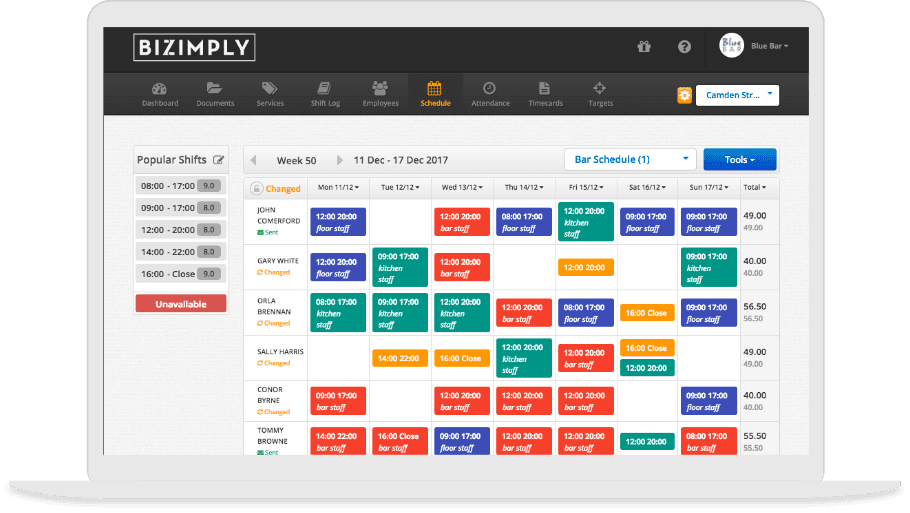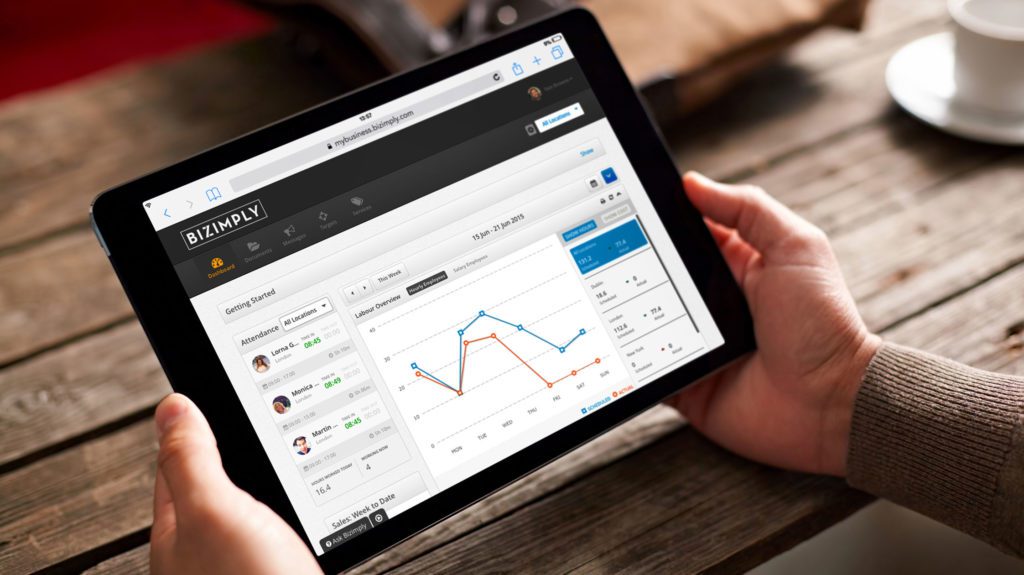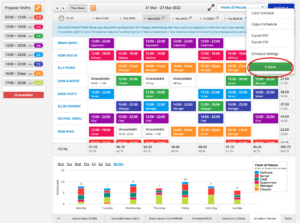FREE E-BOOK
Ultimate Guide to Healthcare Scheduling
Learn the benefits of implementing technology software into your healthcare business to make every shift run like clockwork.
What is a Schedule?
Schedules are designed to aid businesses to run as efficiently as possible; ensuring they have the right amount of experienced staff to willingly align with the businesses’ goals and objectives.
There are a variety of work schedules and they vary on the type of industry of which you are in as well as the season you’re entering. It’s common that if your business operates over a certain
length of time, this is when you focus on shift based scheduling. Not to worry, we will be looking more into the different types of scheduling further into this guide.
How long should it take to me to create the weekly work schedule?
Well if you’re here, I’m thinking it is taking you longer than it should! Other business tasks often get in the way and with payroll or HR tasks to be done, putting together the weekly schedule is the last thing you want to do. I don’t blame you, with time-off requests, staff falling sick and employees not showing up, it can all start to get a little messy! Ugh. But don’t worry Bizimply are here to help.
TIP: Test if you’re spending too long creating schedules – for an entire week, track the time you spend building and managing your team schedule; also factor in changes that have to be made once published, it all uses up valuable time.
DOWNLOAD YOUR COPY NOW!
Why is Scheduling important?
Schedules help businesses around the world save money, maximise productivity, give their employees a more flexible work-life balance, and significantly reduce errors. A schedule becomes much more than a table of data when it is key for optimal business performance.
Wouldn’t it be better to build, fill, manage, and measure best-fit schedules that enable you to meet goals and objectives, all without overspending your labour budget?

1. Reduce time waste
Using a cumulative scheduling system, allows you to avoid wasting employees’ time by scheduling them when they are not required for that shift or are unavailable. You’ll be able to respond to any changes and shift swaps more easily and in a faster time, and you’ll always have insight to real time data.
2. Visibility
As your business grows, it becomes more difficult for managers to know who is on site and what responsibilities they are carrying out for that shift. Especially now, people may no longer be working in the same physical location, or they could be working remotely. Reduced visibility can affect productivity of employees, customer service and costs. You could be paying for people who are absent and incurring unnecessary overtime costs.
3. Get real time data
Get those numbers working. Determine your labour costs through a labour budget tool and/or POS system integration and use past and projected sales to keep your costs under control.
Analyse your footfall; have you noticed that public events lead to an increase in patients? It is important to consider staffing up to cover these busier periods.
4. Schedule for the future with projected sales information
Know your business, down to the nitty gritty. As you accurately predict scheduling needs, your schedules get smarter. This minimises scheduling errors, meaning you can increase engagement and strengthen morale. You may not realise it, but these factors do matter, consider the difference that a single-percent reduction in your labour costs can make. Your weekly, monthly or annual profits can be affected, and the quickest way to reduce labour costs and drive profitability?
Efficient staff scheduling.
Getting the balance right!
ROUTINE

STRATEGIC

The key to saving money is making the routine of scheduling staff, and subsequently tweaking schedules, easy and intuitive. This helps ensure you and your managers get the visibility of what is going on in your business. This then leads to an understanding (the strategic), so you can make smart decisions on your schedule.
The trick is to deploy as few staff as possible, and as many as are necessary. It is quite a tough balancing act. Do labour patterns match sales patterns? It is worth taking time to identify the reasons why things go quiet. Cancellations will happen. There’s no real way to avoid them altogether because things will pop up in your patients’ lives that’ll lead them to cancel their visit. When they happen, though, you’ll want to fill their empty slots as soon as possible. If you don’t, you’re losing revenue.
Healthcare operators have always tried to control the cost of staffing, even more so in recent years. So it is not uncommon for our managers to be scheduling with a target number of hours and/or a target wage and salary base to consider. This can lead to a frustrating experience when scheduling as we constantly check if we have gone over budget, or ask what does each decision mean.
The use of scheduling solutions could,
assuming a conservative estimate of 10% lower travel time,
save 34 minutes per clinician per week,
allowing them to see more patients.
How to get the most out of your scheduling
Proactive Scheduling
Fail to prepare, prepare to fail. As a business owner you should always be planning and looking forward when it comes to scheduling, a proactive approach means you can handle any issues that may suddenly arise for example; staff absenteeism, you want to manage problems in the most efficient and professional way. At Bizimply we are all about having the right people in the right place at the right time.
Automated scheduling
Organisations who implement automated scheduling systems are more than twice as likely as organisations without automated scheduling to provide self-service access to employees. This is an important factor in improving employee engagement and also contributes to schedule accuracy. These organisations are also more than four times more likely to use dashboard tools that can share workforce management data with managers. The Bizimply workforce and labour data dashboards help managers gain insight into the business performance and can understand how the labour budget is spent, in turn this data can be used to help with future labour forecasting.
Control labour spend with effective scheduling
Scheduling software like Bizimply makes it easier for you to build accurate schedules that ensure you have the right amount of staff available and can cover anticipated demand. That way, you can minimise having extra staff scheduled, stop being over reliant on contract workers, and decrease overtime pay which can be the reason your labour costs can be too high.
Measure schedule effectiveness to drive improvements
With the opportunity to pull Reports on Bizimply, it simplifies your scheduling process even more. You have the ability to review previous schedules, measure how effective they were and use this information to enhance the next schedule you create. You can also pinpoint areas where you overspent by examining available budgets versus actual report data. With the scheduled SPLH and Gross Labour costs features, it gives you even deeper insight into these costs as you build your schedule. Amazing right?! Bizimply’s reporting software makes
it easy to generate detailed reports on almost any data in your core HR system with just a few clicks.


5 benefits you will see with improved Scheduling
1. Time
No matter what type of business you’re in, labour scheduling can be a time-consuming, error-prone, and downright frustrating task. You need to match employee skill sets, availability, and preferences with fluctuating business demand in order to maximise productivity and minimise costs. Trying to schedule a workforce using spreadsheets and semi-automated systems too often results in less-than optimal performance, overstaffed shifts or undermanned rushes. Using a cloud based software like Bizimply to build, fill, manage, and measure best-fit schedules enable you to meet business goals, all without overspending labour budgets!
2. Better communication with staff
Poor staff scheduling can have major consequences for always-on operations, even if it doesn’t look like it on the surface. It would be worth implementing an ongoing formal process to review costs, compliance, and other key factors, especially for larger stakes. Publish and communicate the schedule with your employees so that everyone knows where and when to find it. Online scheduling solutions ensure everyone will have access to their schedules anytime and anywhere and they’ll be notified of any changes via the communication methods used.

3. Costs
Optimising schedule costs can help to reduce your spend on overtime and ensure you always have the minimum staffing levels in place to meet forecasted demand. This limits overstaffing and contributes to operating within your budgeted labour costs. However, if peak hours aren’t taken into consideration, performance will be affected and customer demand won’t always be met.
4. Performance & Productivity
Are all hands on deck at your busiest times? There should never be anyone taking their break or working in the office in the middle of service. At peak times, not only are staff on breaks limiting the service you provide to your customers, but they are increasing the pressure on the staff that are working.
5. Happy employees
As we always say, employees are the heart of every company! Treating them fairly and ensuring their happiness is vital to a business’s success. Having perks and benefits that your employees appreciate and are motivated by can contribute hugely to how hard they work and how they treat your customers. Making sure your employees are happy and giving them a great work environment will likely have a positive impact on employee retention.
Ask yourself: Are all your staff fully utilised at all times? If not, what prep work could people be doing? In Bizimply, you can create Daily Task lists for your staff to ensure they are completing all jobs required on their shift.
“I love that staff can now request holidays or submit unavailability through the MyZimply App. Before, there would be phone calls, texts or even notes left in the office. Bizimply gives me a clear overview of who is booked off and allows me to rearrange my schedule accordingly with no hassle.”
10 Ways to Cut Costs When Creating Your Schedule
1. New week, New schedule
Every week is different and your schedule should reflect this. Don’t just recycle last weeks schedule. Ensure you have checked the availability of your staff for the coming week. Check last weeks schedule to see where you may have been overstaffed and look ahead to any large events that may be planned. Don’t leave yourself struggling to cover shifts at the last minute.
2. Cost & build
Bizimply allows you to cost as you build which is great to see where you can save. If you wait until the end then it becomes a mad dash to cut hours and stay on budget, which always leads to inefficient schedules.
3. Set clear targets
Without clear targets there is no way to ensure a steady labour cost. Work out what your current target labour cost is based on this weeks schedule and see if you can reduce it by 5% for next week.
4. Monitor targets
Target sales per labour hour (SPLH) is a great key performance indicator (KPI) to track for your business. If you have target sales of £2000 and target hours of 40 then your SPLH is £50. Try and maintain a steady SPLH throughout the week and don’t let it fluctuate with sales patterns. This will also ensure you have adequate staff cover for each day.
5. Arriving together?
Do all your staff arrive at the same time for each scheduled shift? Do you need all your staff to be in at the same time? Most shifts require a bit of prep work which usually only takes one or two people. If you adjust your shifts to start in 15 or 30 minute increments then your staff will arrive as you need them.

6. Are labour patterns reflecting sales?
When your sales increase your labour cost may increase but when sales decrease do your labour costs decrease? In order to achieve a reduction in costs you have to schedule accordingly and anticipate periods of low sales as well as high sales.
7. Be Flexible
Rarely do shift workers have control of their schedules. This can have a huge impact on their lives, making it hard for them to plan outside of work. For part-time workers, hourly workers, the deskless workforce, or people working in the gig economy, this also increases the challenge of working multiple jobs and calculating their income, as their hours can fluctuate wildly.
8. KPI’s
Help your managers to perform better and achieve your organisation’s standards using a wide range of configurable KPIs embedded with the schedule. Assess and analyse each location against the same set of KPIs or de-fine location-specific measurables.

9. Overtime
With wages on the rise, it can be a struggle to keep labour costs under control. One way you can offset the impact of rising wages is by controlling overtime. Other than last-scheduling needs, it’s difficult to justify spending an additional 50% for work that could have been handled more affordably. Set realistic overtime goals with your team. While it might be unreasonable to shoot for no overtime, a 25% reduction might be more doable. Help your team reach these goals by showing them alternative solutions to using overtime that will save you money.
10. Outside business hours
If your employees are working outside of business hours, you’re losing money. To minimise your loss, schedule as few people as possible for prep and closing shifts. Then, aim to have employees complete most no-service tasks while you’re open for business and generating revenue.
To help identify these opportunities, ask yourself:
- Can some of these tasks be completed while the business is open?
- Am I overstaffed for opening and closing shifts?
Remember, healthcare labour cost is 100% when there is no revenue to pay for it!
Opitimising Your Schedule
Optimisation plays a crucial part in any business and smart scheduling gives you the power to choose how to optimise your business.
So, what does optimisation look like?
The right data, the right people, the right tools
Optimising labour costs is best managed from the top down with an investment in technology that enables operators. When companies invest in the right technology to measure in-coming data, success will follow when used right. Best practices can be more easily shared across multiple practices or homes when there is a deeper insight into data available. If one location consistently reaches and manages labour targets whilst other locations underperform that can be leveraged.
Full visibility and ownership to Employees
Having engaged and empowered staff who strive to perform; achieving goals and objectives are an advance for any hospitality brand. Expressing a strong connection between performance and results as expressed in the data is vital to meeting that goal. It enhances the value of labour against its rising costs, which is an important facet of ROI.
Most people want to do their best at whatever they do from location managers to waiting staff. Regularly showing staff where they can improve and who is doing the best job based on real business data is an important means to extending a sense of connection and owner-ship to them. It gives them a stake in the success of the business. By extension, it’s also the best way to get the most out of them as employees, which makes the expense of employ-ing them more meaningful and more valuable to the organisation.
As the cost of labour rises, being able to attach more corresponding value to that expense by investing in the best performers just makes sense. Collecting and reporting on real business data like this, held in the cloud and accessible while on the move via mobile devices can serve the brand, individual operators, and ultimately employees too.
What do your employees want from a Schedule?
Certainty
Employees want to be able to plan their lives for more than a few days in advance. They want to be able to rely on their managers and be reassured they won’t be messed around and can count on the schedule accuracy first time round. This avoids employees making unnecessary journeys to work or getting annoyed if there has been a mix up of shifts – especially without being notified.
Stability
The majority of staff only have one job and strongly rely wages of that job. Therefore, they want their hours to be guaranteed and roughly the same every week to help them manage their money effectively. They prefer it when managers base the rota on a set pattern, so they can be reasonably certain of their hours before the rota has even been published. If managers drastically change staff hours from week to week, you’ll get some angry and upset employees.
Mobile Compatibility
Mobile-first WFM solutions will be co-assisted with an app that needs to be manageable and as simple as other apps they may use on the daily. Taking this approach allows you to get into more detail that you may not have considered before – peak times, management level on each shift, number of employees needed for each time slot; in turn, this drives sales. These are the kind of results we want to deliver on and lead to a happier workplace overall.

“1 out of 3 have left a job because their employer did not provide schedules with enough advance, making it difficult for them to balance their work and personal life.”
Notified of changes
Every time there’s a change to the rota, employees want to be made aware of these changes; especially if it involves them. Whether this is change of starting time, swapping shifts with another employee or even last minute emergencies of needing to close. An effective communication system must be in place to prevent rota communication problems and confusions.
Shift run-down
Employees always like to have a rough idea of what they are going to walk into when they arrive to work. Yes, the majority of shifts will be the same responsibilities and roles but even finer details of who is opening or closing the store for that day, whether they have larger parties in or perhaps if they are on a training course that day. Providing a brief outline of what to expect can prepare your employees in the best way for their shift.
An easy-to-use time off request system
Asking for time off shouldn’t be an administrative nightmare. It’s important to give employees independence and autonomy when it comes to putting in time-off requests. Bizimply provides two options when it comes to employees booking time off; on the mobile app and on the desktop app available through the employees personal profile.

Rules, Rules, Rules!
Scheduling rules based on these factors may also be unique to your organisation, so clear guidelines are extremely important. To avoid confusion, make sure that all managers understand the policies or rules before shifts are assigned.

Training and Certifications
Do particular shifts require personnel who are certified with specific training? If so, put rules in place to ensure only people with current certifications are considered for assignment during those shifts.

Seniority
Is seniority status given to employees for certain shifts? Those guidelines will need to be reflected during scheduling as well.

Compliance to Safety, Employment, and Labor Laws
Ensure staff aren’t working longer than is allowed by law and what is outlined in their contract. You’ll also need to track and comply with any internal or external overtime restrictions.

Employee Performance
Sometimes, you need your best people on the job, but identifying them can be difficult. This is especially true in large or complex organisations where staff take on multiple roles. Track performance ratings, so you know who to schedule when it matters most.
Scheduling with intentionality is critical for maximising daily productivity on every shift.
How can you achieve this?
Let’s look at the criteria below:
Availability
From Holiday requests to leaves of various kinds, employee availability issues are the number one driver of schedule changes. During the pandemic, employers must also consider employees’ requests for schedule changes due to fluctuating school schedules for kids, caring for loved ones with COVID-19, and when they’ve had exposure and are required to isolate.
Preferences
When you take employee preferences into account, you reduce change requests. More importantly, you improve employee satisfaction while lowering absenteeism and turnover.
Rich Profile Configuration
You likely have extensive information on your employees that you need to leverage in scheduling and reporting. This information often includes role, job-level, credentials, seniority, pay rates, and availability preferences for each employee.
Automating Shift Assignment
Assigning shifts is typically the most time-consuming portion of the scheduling process. Manually matching people with positions is difficult and keeping all the details straight sounds easier than it is. Employee scheduling software can help. Bizimply allows you to copy weekly schedules to save time in this area whilst encompassing the rules we discussed above.
Forecasting Accuracy
Comparing forecasted to actual resource demand is a key review point. As you are creating schedules, you have a unique perspective. Use this to your advantage to review variances and collaborate across your organisation to improve your predictive accuracy. You would be surprised how a minor improvement can impact your business overall!

Managing Resources
It is critical to monitor and measure the health of your labour resource. Consider the time period and expected demand when reviewing employee availability. Are you coming into Summer where increase in holiday requests occur but patient appointments increase too as more people are off? Preparing for this spike means you can proactively adjust the schedule due to the information being integrated. Also, monitoring resource pools tied to critical positions will ensure you always fill them with the best talent. If you are using employee scheduling software, you have a valuable data source so you’re on the right track!
Workforce Scheduling Processes
Review key processes with other schedulers, management, and employees and regularly test ideas to evaluate if you observed any improvements. In shift-based work environments, the schedule has a significant impact on employee productivity and morale. Employee feedback will reveal factors that may be difficult to see from a scheduling perspective
Forecasts: Why are they important?
In order to build a smart schedule, forecasts are essential. It provides you with the ability to present a forecast to local managers for them to edit or have as context when scheduling. Forecasts may be presented to Bizimply ready to go, or the tool may use historical data to generate the forecast. Forecasts are the difference between turning a profit and making a loss. Executing advanced, on-demand forecasting, allows you to create optimal schedules based on your projections and historical data. When you balance your planned costs against your results, you create the most profitable resource plan. Proficient forecasting goes hand in hand with smarter scheduling and gives you the data that is necessary for you to know you’ve got the right employees working your shifts! Pivoting new sales channels affect your Labour
Here are 5 Steps to Perfecting Healthcare Business Forecasting:
- Keep organised and accurate records of all your data to improve forecasting.
- Utilise past performance data, the numbers are there so make good use of them!
- Be in the know when it comes to industry trends and observe them closely. Also, keep an eye on what your competitors are doing, they might have come across something you’ve missed.
- Don’t set it and forget it when it comes to your forecasts, refer to them regularly. Re-view your predictions and compare them to your actuals, were your assumptions correct? If not, make edits to the forecasts where necessary.
- Stay close with the marketing team so they can update you on the latest trends and issues surrounding the market.
So that’s it! The Ultimate Guide to Scheduling and the importance of doing it right. Reach out to one of our business solutions advisors today for a chat and how Bizimply can improve your scheduling processes.
